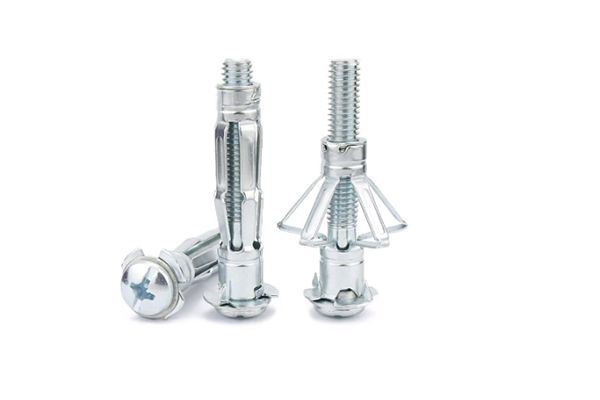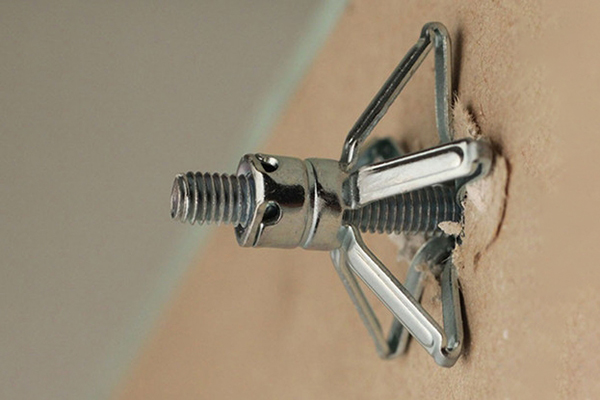This article provides a detailed overview of hollow wall anchors, explaining their uses, types, and installation methods. Whether you’re a professional in construction, mining, or geotechnical engineering, or simply tackling a DIY project, understanding how to use hollow wall anchors can significantly enhance the security and durability of your fixings. This guide is worth reading because it combines practical advice with industry insights, helping you choose and use the right anchor for any situation, ensuring your projects meet the highest standards of safety and reliability.
1. What are Hollow Wall Anchors and Why Use Them?
Hollow wall anchors are specialized fasteners designed for use in walls with a hollow space behind them, such as drywall or plaster walls. Unlike solid walls where a simple screw might suffice, hollow walls lack the internal structure to grip a screw securely. This is where wall anchors come into play. They provide a secure hold by expanding or otherwise engaging with the back side of the wall material, distributing the load and preventing the screw from pulling out.
Using hollow wall anchors is crucial when hanging heavier objects or when ensuring long-term stability. Without an anchor, the weight of the item could cause the screw to tear through the drywall, leading to damage and potential safety hazards. Think of mounting a heavy mirror or shelf – using the correct drywall anchor prevents accidents and protects your walls. Choosing the right type of anchor improves the holding strength of a screw
2. What are the Different Types of Hollow Wall Anchors?
There are several types of hollow wall anchors, each designed for different weight capacities and installation methods. Understanding these differences is crucial for selecting the right fastener for your specific needs. Some common types include:
- Toggle Bolts: These anchors feature spring-loaded wings that expand behind the wall, providing a very strong hold. Ideal for heavy items.
- Molly Bolts: These have a metal sleeve that expands as the screw is tightened, creating a secure grip within the drywall.
- Expansion Anchors: These anchors expand as the screw is driven in, wedging themselves against the wall material.
- Plastic Anchors: Suitable for lighter loads, these anchors are made of plastic and expand slightly when a screw is inserted.
- Self-Drilling Drywall Anchors: These are designed to screw directly into drywall without the need for pre-drilling, offering convenience for lighter applications.
- Threaded Drywall Anchors: A type of self-drilling anchor that looks like a large screw.
Choosing among the numerous types of wall anchors relies primarily on the item’s weight and the specific wall substance.
3. How Do Toggle Bolts Work in Hollow Walls?
Toggle bolts are among the strongest hollow wall anchors available. They consist of a long bolt and a spring-loaded, winged toggle. To install a toggle bolt, you first drill a hole large enough for the toggle to pass through when folded. The toggle is then attached to the bolt and inserted into the hole.
Once inside the wall, the spring-loaded wings expand, creating a large bearing surface against the back of the drywall. As the bolt is tightened, the wings are pulled tight against the inside of the wall, providing exceptional holding power. Toggle bolts can hold a significant amount of weight, making them ideal for applications like mounting heavy shelves or cabinets. However, they require pre-drilling a larger hole and can be more difficult to remove than other types of anchors.
4. Are Molly Bolts a Reliable Choice for Drywall?
Molly bolts, sometimes called mollies, are another popular choice for drywall. They offer a good balance between strength and ease of installation. A molly bolt consists of a metal sleeve with a pointed tip and a screw. To install, you typically drill a pilot hole slightly smaller than the diameter of the sleeve.
The molly bolt is then tapped into the hole until the head is flush with the wall material. As the screw is tightened, the sleeve expands behind the drywall, creating a secure anchor. Molly bolts provide a more secure hold than plastic anchors and are suitable for medium-weight items. They are a good choice for applications where you need a stronger hold than a simple screw but don’t need the extreme weight capacity of a toggle bolt.
5. How to Install Expansion Anchors: A Step-by-Step Guide
Expansion anchors, also known as plastic expansion anchors or wall plugs, are commonly used for lighter to medium loads in drywall and other materials. Here’s a step-by-step guide to installing them:
- Choose the Right Size: Select an expansion anchor that matches the size of the screw you intend to use and the weight of the item you’re hanging.
- Drill a Pilot Hole: Drill a pilot hole that is the same diameter as the anchor body (not the screw).
- Insert the Anchor: Gently tap the plastic anchor into the hole until it is flush with the wall surface.
- Insert the Screw: Drive the screw into the anchor. As the screw goes in, it will cause the anchor to expand and grip the surrounding wall material.
Plastic expansion anchors are relatively easy to install and remove, making them a convenient choice for many applications. However, they are not suitable for very heavy items or situations where extreme holding power is required.
6. Why Choose Plastic Anchors and When to Avoid Them?
Plastic anchors, including winged plastic anchors and plastic ribbed anchors, are a cost-effective and readily available option for light-duty applications. They are suitable for hanging pictures, small shelves, and other lightweight items on drywall.
However, plastic anchors have limitations. Their holding power is significantly less than that of metal anchors like toggle bolts or molly bolts. They are not recommended for heavy items or for applications where the anchor will be subjected to significant stress or vibration. If you need to hang something heavy, or if you need a very secure hold, it’s best to choose a metal anchor. Avoid using the anchors for heavy loads, applications requiring a very secure hold, and materials other than drywall or plaster.
7. What Makes Self-Drilling Drywall Anchors Unique?
Self-drilling drywall anchors, as the name suggests, eliminate the need for pre-drilling a pilot hole. These anchors have a sharp, pointed tip and coarse threads that allow them to be screwed directly into drywall.
These anchors are ideal for quick and easy installations of lightweight items.
Self-drilling anchors are typically made of either plastic or metal (often zinc-plated steel). They are a convenient option for hanging pictures, small decorations, and other lightweight objects. However, like other plastic anchors, they are not suitable for heavy loads. Also, be careful about overtightening. While self-drilling anchors simplify the installation, it is important not to overtighten, which can lead to stripping of the drywall.
8. How to Determine the Right Anchor Size and Weight Capacity?
Selecting the right type and size of anchor is crucial for ensuring a safe and secure installation. The anchor’s weight limit should always exceed the weight of the item you are hanging. Anchors are typically rated for a specific weight capacity, which is usually indicated on the packaging.
Here are some factors to consider:
- Weight of the Item: This is the most important factor. Always choose an anchor with a weight capacity that exceeds the weight of the object.
- Wall Material: Drywall, plaster, and concrete all have different holding strengths.
- Anchor Type: Different types of wall anchors have different weight capacities. Toggle bolts generally have the highest, followed by molly bolts, then expansion anchors, and finally plastic anchors.
- Thickness of the drywall: Some anchors are made for thicker and thinner walls.
It’s always better to err on the side of caution and choose an anchor with a higher weight capacity than you think you need.
9. Best Practices for Installing Anchors in Drywall and Plaster
Here are some best practices for installing anchors in drywall or plaster:
- Use a Stud Finder: If possible, locate a wall stud and attach your item directly to the stud using a screw. Studs provide the strongest possible support. Use a stud finder to locate these.
- Drill a Pilot Hole (When Necessary): For most metal anchors (and some plastic ones), drilling a pilot hole is essential. Use a drill bit that is slightly smaller than the diameter of the anchor.
- Don’t Overtighten: Overtightening can damage the drywall or strip the anchor. Tighten the screw until it is snug, but don’t force it.
- Consider the Angle: If you’re hanging something heavy, consider angling the screw slightly upward to provide additional support.
- Test the anchor: Before placing the object fully, gently tug on the installed anchor to make sure of its stability.
Following these tips will help ensure a secure and long-lasting installation.
10. Troubleshooting Common Issues with Hollow Wall Anchors
Even with careful installation, you may encounter some issues with hollow wall anchors. Here are some common problems and how to solve them:
- Anchor Pulls Out: This usually indicates that the anchor is not the right type or size for the weight of the item or the wall material. Remove the anchor and choose a more appropriate one.
- Anchor Spins in the Hole: This can happen if the pilot hole is too large or if the drywall is damaged. Try using a slightly larger anchor or patching the hole and re-drilling.
- Screw Won’t Tighten: This may indicate that the anchor is not fully expanded or that the screw is too short. Try a longer screw or a different type of anchor.
- Anchor is Difficult to Remove: Some anchors, like toggle bolts, are designed to be permanent. If you need to remove an anchor, you may need to carefully cut it out or push it through the wall.
Understanding these common problems and their solutions can save you time and frustration.
11. How wall thickness will determine which anchor to use?
The thickness of the wall plays a crucial role in selecting the appropriate anchor. Different anchors are designed to work with varying wall thicknesses, ensuring a secure and stable hold.
Thin Walls (e.g., 1/4 inch drywall):
- Suitable Anchors: Lightweight plastic anchors, self-drilling drywall anchors, and small molly bolts are often suitable for thin walls. These anchors don’t require a deep cavity to expand and grip effectively.
- Considerations: Avoid heavy-duty anchors like toggle bolts, as the wings may not have enough space to fully expand behind the thin wall.
Standard Walls (e.g., 1/2 inch or 5/8 inch drywall):
- Suitable Anchors: Most types of hollow wall anchors, including toggle bolts, molly bolts, expansion anchors, and plastic anchors, can be used in standard-thickness walls.
- Considerations: Choose the anchor based on the weight of the item being hung and the desired level of holding strength.
Thick Walls (e.g., double-layered drywall, plaster over lath):
- Suitable Anchors: Longer toggle bolts, molly bolts with longer screws, and specialized heavy-duty anchors designed for thick materials are recommended.
- Considerations: Ensure the anchor’s length is sufficient to reach through the entire thickness of the wall and engage properly. Standard-length anchors may not be long enough to provide a secure hold.
- Pilot Hole: Use a drill and the correct sized drill bit to drill your pilot hole.
In summary, before selecting an anchor, always measure or estimate the wall thickness to ensure the chosen anchor will function correctly and provide adequate support.
As Allen from China, a representative of a B2B factory with 7 production lines specializing in self-drilling anchor systems and drilling tools, I can attest to the importance of understanding these principles. We export to the USA, North America, Europe, and Australia, serving construction companies, mining companies, tunneling contractors, and geotechnical engineering firms. Our products, including anchor bars, anchor bits, anchor nuts, and more, are manufactured with high-quality materials for reliability and durability. We also provide comprehensive product range and compliance with international safety standards.
We understand the needs of professionals like Mark Davis, a company owner and procurement officer in the USA, who values quality, competitive pricing, and efficient logistics. He seeks suppliers at exhibitions and through Google searches, prioritizing certifications like ISO standards. We address his pain points – inefficient communication, shipment delays, and certificate fraud – by providing clear communication, reliable shipping, and genuine certifications. For technical questions, we offer complete document support.
Key Takeaways:
- Hollow wall anchors are essential for secure fastening in walls with a hollow space behind them.
- Different types of anchors exist, each with varying weight capacities and installation methods.
- Toggle bolts provide the strongest hold, while plastic anchors are suitable for light loads.
- Always choose an anchor with a weight capacity that exceeds the weight of the item you’re hanging.
- Proper installation techniques are crucial for ensuring a safe and secure hold.
- Troubleshooting common issues can save time and frustration.
- The wall’s thickness is a deciding factor for the type of anchor.
- Use active voice.
Post time: 3 月-21-2025
















